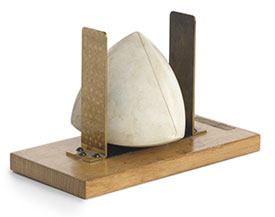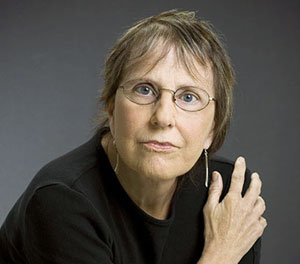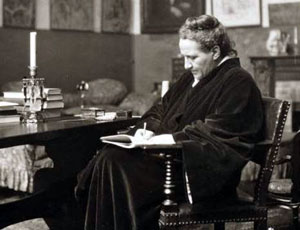|
Since February 19, 2015, the Steiny Road Poet has been weighing similarities between the work of Man Ray, Rae Armantrout, and Gertrude Stein. On that date poet Rae Armantrout was invited to match her work to an unusual art exhibition by Man Ray at the Phillips Collection in Washington, DC.
THE MATH OBJECTS MAN RAY TRANSFORMED TO SHAKESPEARE

In Steiny’s experience, Man Ray (né Emmanuel Radnitzky August 27, 1890 – November 18, 1976) was known as an experimental photographer who contributed to the Dada and Surrealist movements. He also photographed Gertrude Stein.
“Man Ray—Human Equations: A Journey from Mathematics to Shakespeare,” running from February 7 to May 10 at the Phillips Collection demonstrates his versatility as a photographer, painter, and thinker working at the intersections of mathematics, science, and conceptual art. The focus of the Phillips Collection exhibition is how Man Ray studied mathematical models warehoused at the Institut Henri Poincaré in Paris. These neglected models were made from such materials as plaster, wood, papier-mâché, and string. Man Ray photographed them and then he created interpretive oil paintings that he further conceptualized by giving them titles of plays by William Shakespeare.
For example, using the Mathematical Object known as a Kummer Surface with Eight Real Double Points, Man Ray created a gelatin silver print that dramatically energizes this model by using a black background with a glowing white top surface with a complementing, but less bright, bottom platform while other projecting parts of the model are in shadow. Then he developed an oil painting that looks like a human figure with arms opened wide, wearing a flowing robe and a more-or-less crescent shaped headdress, suggestive of a crown. This oil painting he named Shakespearean Equation, King Lear.
In all good faith, Steiny attempted to understand what a Kummer Surface might be. Without any stable discernment, she got this—a Kummer surface pertains to algebraic geometry and the definition uses language that might as well not be English. However, discussion of the Kummer Surface uses such terms as nodes, points, curves, sets, double cover as well as using double negatives like—union of two non-empty closed sets, either disjoint or non-disjoint—which is much like the language Gertrude Stein employed in her long love poem Tender Buttons and that tends to have mathematical and metaphysical shadings. Apparently what fascinated Man Ray was the shape and contours of the object because he said he had no idea what the model represented mathematically though it intrigued him.
ARMANTROUT’S RESPONSE TO MAN RAY’S BREAST
To Man Ray’s progressive complexity, Teri Cross Davis, the poetry coordinator at the Folger Shakespeare Library, invited Rae Armantrout to give a reading in which she (Armantrout) would respond to artwork in this Man Ray exhibition. For example, Armantrout paired her poem “Taking Place” which features the push-up bra as the poem opens and memory of a battle accented by “the far-off roar of traffic” with Man Ray’s Shakespearean Equation, Hamlet. Based on the mathematical object Surface of Constant Width, made from plaster and mounted on a wooden base, Man Ray’s Hamlet at first glance looks like an inflated triangle but upon careful examination appears to be a woman’s breast complete with a pointing nipple.
|
 |
 |
|
|
|
D) Mathematical Model
|
|
|
|
|
Man Ray’s reduction of Hamlet to an accusatory breast (the nipple points) is out-of-the-box brilliant. Most people with the slightest knowledge of Shakespeare’s Hamlet can quote from Hamlet’s soliloquy “to be or not to be.” The mother’s breast in that time was integral with fragile life. Also Hamlet suggests various triangles and here are some of the major ones: King Hamlet-Queen Gertrude-Prince Hamlet, Hamlet-Ophelia-Polonius (Hamlet accidentally kills Ophelia’s father Polonius whose death causes Ophelia to commit suicide. In turn Ophelia’s death makes Hamlet reveal the great depth of love he had for her.), Claudius-Hamlet-Ghost of King Hamlet, and Claudius-Gertrude-Hamlet.
Hamlet continuously addresses existence and even the dead, like Hamlet’s murdered father continues to present himself as a ghost. In Armantrout’s poem “Taking Place,” the title puts an emphasis on immediacy—what is happening is going on right now.

TAKING PLACE
By Rae Armantrout
Once we liked the conspicuous
but constrained,
the push-up bra
under the shirt-waist,
a small bow
at the throat,
the appearance
of a struggle
toward the diminutive,
the punctum.
*
The slender
second hand
jerking forward
as if helpless,
making its same sound.
*
We might stand
in a thicket
where a battle had
taken place
and be thrilled
by the far-off roar
of traffic
published in Poetry (January 2015)
Copyright © 2015 Rae Armantrout
Armantrout, like Shakespeare, manages, with few words, to situate her audience between the past (“where a battle had taken place”) and present (where “the far-off roar of traffic” thrills). Armantrout makes her fine point (punctum) about existence with clothing worn on a woman’s body, particularly on the breast. Also there seems to be great effort in maintaining this existence (“appearance of a struggle,” that “slender second hand jerking forward as if helpless” which leads to the conjectured thicket where “a battle had taken place”). The “second hand” might be referring to the minute hand on a clock, an old clock that makes noise as it operates.
THE BUZZING MULTIPLICITY OF ANY OBJECT SEEN
What Armantrout achieves with her impressionistic ambiguities is very Steinian if not Tender Buttons-ish. Armantrout’s emphasis on existence and appearance as tied to the feminine sex lines this poem up with such Tender Buttons subpoem as “A Long Dress.”—“What is the current that makes machinery, that makes it crackle, what is the current that presents a long line and a necessary waist. What is this current.” (Stanza 1 of 3) In both poems, the reader gets an impression using elements that could pertain to more than one thing but also pinned to the female gender.
Stepping back from the artworks of Man Ray, Rae Armantrout, and Gertrude Stein, one might notice how each handles objects. Man Ray moves from obscure mathematical models to artistic photographs and finally to a conceptual oil paintings tied to the psychological plays of Shakespeare.
Rae Armantrout in various interviews over the years and presentations including the February 19 reading at the Phillips Collections talks about how separate and incongruous objects play a role in her poetry. In an interview for The Argotist Online with Amy King, Armantrout, around the subject of why she writes poetry, discussed the psychological approach objects have for her, “Once thoughts and feelings have been made into the pseudo object of a poem, they tend to give you pleasure instead of pain.” In an interview conducted by Ben Lerner for BOMB magazine (winter 2011), Armantrout said, “As we know from physics, and from neuroscience, any single object we will ever see is, in fact, a buzzing multiplicity which we have found it practical to identify as a single entity. We ourselves are colonies of cooperating (knock wood) cells.
In Tender Buttons, Stein takes the objects of daily living and uses them not only to work out her theories of a new grammar but also to express her love for her partner Alice Toklas and to show the breadth and scope of our universe in all its dimensions of nature, science, mathematics, philosophy, and various beliefs systems.
What is at play with these three artists is how they move from the physical identification of a subject seeing a thing to the idealized construct, an attempt to locate what is universal. It’s also an attempt to comment on the human condition.

Did Gertrude Stein influence Man Ray? Certainly they had contact but it is hard to say and one must keep in mind that Tender Buttons was published in 1914 while Man Ray’s Shakespearean Equations immerged after World War II and after Stein’s death in 1946. Clearly Rae Armantrout exhibits Stein’s influence but she (Armantrout) doesn’t go out of her way to cite Stein. As in Man Ray’s case, Armantrout benefits from a literary zeitgeist that cannot be escaped. Gertrude Stein’s influence gets stronger as the years unroll because more people are reading and appreciating her.
Photo Credits:
A) Mathematical Object: Kummer Surface with Eight Real Double Points,
c. 1900. Plaster with metal supports, 7 1/2 × 11 × 5 7/8in. Brill-Schilling Collection. Institut Henri Poincaré, Paris. Photo: Elie Posner.
B) Man Ray, Mathematical Object, 1934–35. Gelatin silver print, 9 × 11 in. Collection L. Malle, Paris. © Man Ray Trust / Artists Rights Society (ARS), NY/ADAGP, Paris 2015.
C) Man Ray, Shakespearean Equation, King Lear, 1948. Oil on canvas,
18 1/8 x 24 1/8 in. Hirshhorn Museum and Sculpture Garden, Smithsonian Institution, Washington, DC. Gift of Joseph H. Hirshhorn, 1972. © Man Ray Trust / Artists Rights Society (ARS), NY / ADAGP, Paris 2015. Photography by Cathy Carver
D) Mathematical Object: Surface of Constant Width, c. 1911–14. Plaster and wooden base, 6 3/4× 101/4 × 51/8in.Brill-Schilling Collection. Institut Henri Poincaré, Paris. Photo: Elie Posner.
E) Man Ray, Shakespearean Equation, Hamlet, 1949. Oil on canvas, 16 x 20 1/8 in. The Cleveland Museum of Art, Bequest of Lockwood Thompson 1992.301. © Man Ray Trust / Artists Rights Society (ARS), NY / ADAGP, Paris 2015
|